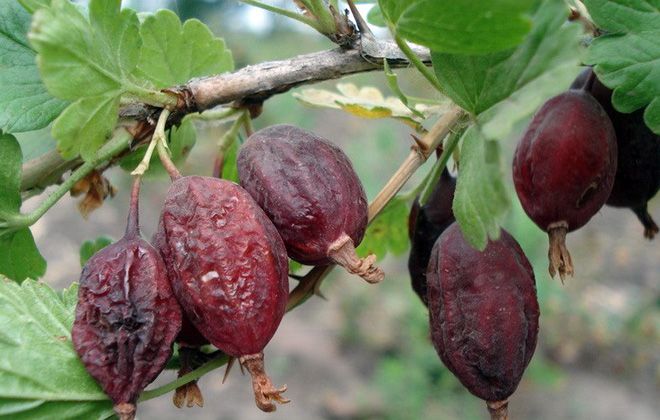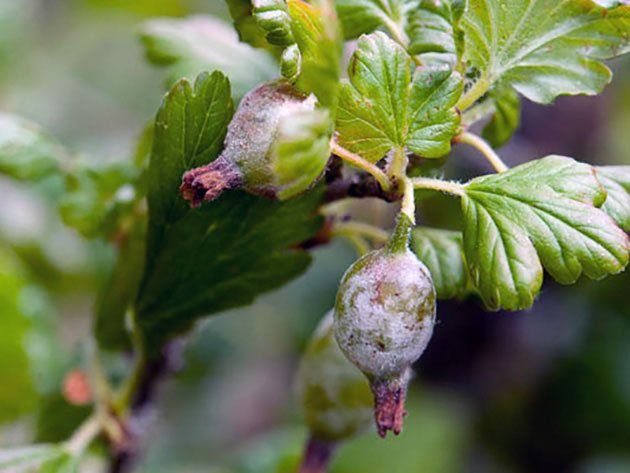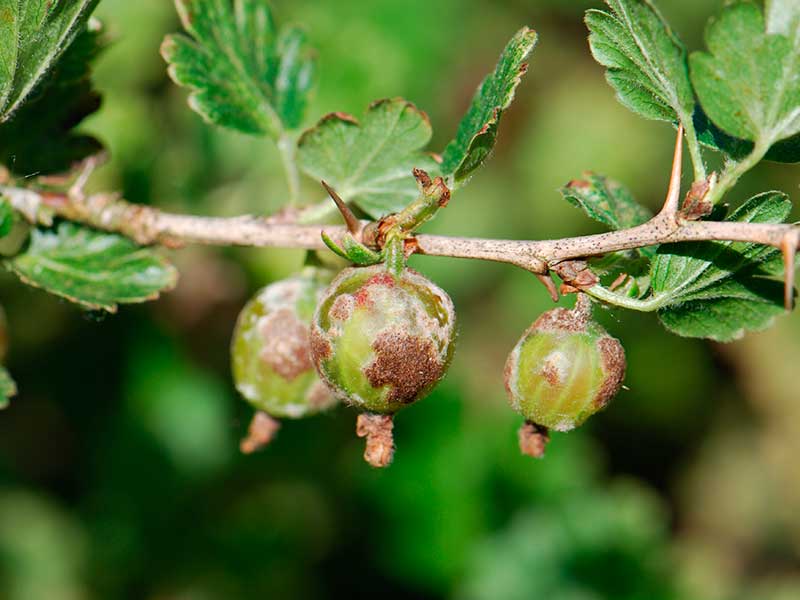Why do gooseberry berries rot on a bush and what to do about it
Gray mold and powdery mildew are the most common fungal diseases in gooseberries. With gray rot, dry gray-brown spots appear on the stems, which spread over the entire surface of the berries, and the stalk is covered with a fluff of the same shade. With powdery mildew, a whitish, fluffy bloom forms on the fruits and leaves. Without proper treatment, both diseases lead to the death of the bush.
The content of the article
Why gooseberry berries rot: reasons

Gooseberries are known for their unpretentious care and resistance to various diseases, but sometimes even with proper care, gardeners notice white, gray or brown berries stains.
Gray bloom and rotten berries are signs of gray rot caused by fungal spores. The disease spreads from the bottom up. Initially, the lower shoots and leaves are covered with a gray bloom, which later envelops the berries, they begin to rot and fall off. The leaves lose their elasticity, turn yellow and dry.
The next stage of the disease is moldy light gray patina, brown areas, dying off of plant tissues.
The disease reduces the winter hardiness and productivity of the plant, leads to a delay in growth and development, and stops the process of photosynthesis. Gray rot develops with high humidity and as a result of thickening of the bushes. The wind spreads spores to neighboring plants, infecting vegetable and fruit crops.
Reference. Gray mold is not a typical gooseberry disease. Fungal spores often affect carrots, cabbage, beets, apples, pears, and apricots.
American powdery mildew, or spheroteka, - the most common fungal disease of the gooseberry. Immediately after flowering, a characteristic arachnoid bloom appears on the leaves.
As the disease progresses, the plaque turns gray, then turns brown and becomes dense. The shoots stop developing, they are deformed, the berries do not have time to ripen, they become covered with white fluff and fall off. Spheroteca develops in conditions of high humidity, with prolonged rains and warm weather.
European powdery mildew also develops in warm and humid weather... A loose white bloom appears on green berries, which gradually thickens and turns into a brown crust, and cracks appear on the surface.
How to deal with gray mold and powdery mildew on gooseberries

The success of the fight against gray mold and powdery mildew depends on the speed of the gardener's reaction. The sooner he notices the signs of diseases and begins to fight them, the higher the chances of the plant for recovery.
Destruction of infected leaves and berries
At the first signs of gray rot and powdery mildew, it is recommended to cut off infected shoots along with leaves and berries and burn them away from the site.
Fungal spores feel great in plant debris, hibernate in them and in spring, with the onset of heat, they activate vital activity. Therefore, in early spring, after cutting the bushes, shoots are collected from the site along with dry foliage.
How to process
The fight against powdery mildew begins after the first signs appear. If the plaque is covered with gooseberries during flowering or fruiting, a solution of soda ash is used for treatment (5 g of soda and 40-50 g of shavings of laundry soap per 10 liters of water). The bushes are sprayed 2-3 times with an interval of 7-10 days.
If powdery mildew manifests itself before the buds open, the bushes are treated with fungicides:
- "Nitrofen";
- 3% solution of ferrous sulfate;
- 1% solution of copper sulfate;
- Fundazol;
- "Horus";
- "Topaz".
In the spring, the site is dug up and the soil is mulched with peat.Before bud break, gooseberries are sprayed with copper (50-100 g per 10 l of water) or iron (300 g per 10 l of water) vitriol.
Instead of fungicides, an infusion of mullein is used (1/3 of 10 liters of a bucket of fresh mullein is left for 3 days in a warm place, then filtered and diluted with water 1: 3). Processing is carried out three times: before flowering, after another 14 days and after harvesting for prevention.
Reference.The most resistant to powdery mildew gooseberry varieties are English yellow, Northern Captain, Eaglet, Consul, Chernomor.
If powdery mildew has appeared on young shoots, 300 g of wood ash and 50 g of laundry soap per 10 liters of water are used for treatment. Of biofungicides, Fitosporin is the safest for the plant and the environment. In the later stages of the disease, the most effective remedy is used - 1% Bordeaux liquid.
Fungicide treatment is performed before fruit appears. Spraying is usually done before and during flowering.
The same means and methods are used against gray rot. The preparations "Falcon", "Zircon", "Horus", "Strobi" are especially effective.
How else to process gooseberries, which have a gray bloom:
- In early spring, the bushes are watered with boiling water, destroying more than 50% of fungal spores.
- Before bud break, use a 3% solution of Bordeaux mixture (400 g of quicklime, 300 g of copper sulfate per 10 liters of water). It is recommended to irrigate the trunk circle and bushes.
- Wood ash is embedded in the soil under the bush and watered settled water.
- For 3 liters of water, take 1 kg of hay dust or rotted hay and leave for 3 days. The product is diluted with 10 liters of water and sprayed on the bushes in the evening or during the day in cloudy weather. Beneficial bacteria eat the powdery mildew mycelium, which is invaluable help to the gardener. Processing is carried out three times: before and after flowering, before leaf fall.
Potent drugs are used according to the instructions: "Fitosporin" - 15 ml per 10 liters of water, "Oxyhom" - 20 g per 10 liters, "Topaz" - 1 ampoule per 10 liters.
Prevention of gray mold and powdery mildew

Methods for the prevention of gooseberry fungal diseases:
- crop rotation;
- loosening the soil;
- moderate watering;
- thinning the landings;
- harvesting infected shoots, leaves and berries;
- planting varieties and hybrids resistant to powdery mildew: Houghton, Joselin, Curry, Sadko, Russian, Pushkinskiy Rose-2, Plum, Rodnik, Lada;
- moderate nitrogen application;
- sanitary pruning of bushes;
- planting plants in ventilated areas;
- spring treatment with "Zircon".
Conclusion
Gardeners who grow fruit and berry bushes periodically notice a gray or whitish bloom on shoots, leaves and fruits, see how gooseberries rot on the bushes, and often do not understand what to do. To understand why the fruits rot, it is important to understand the nature of this phenomenon. In most cases, a fluffy coating of gray, brown or white appears as a result of the spread of spores of fungi that cause gray rot and powdery mildew.
Bordeaux liquid, soda ash, copper and iron vitriol, fungicides are used to treat diseases. Agrotechnical practices - moderate watering, loosening the soil, pruning bushes, planting varieties with strong immunity, thinning, maintaining crop rotation - reduce the risk of spore spread to a minimum.